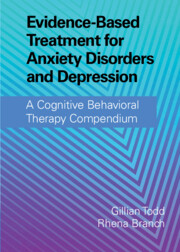 Evidence-Based Treatment for Anxiety Disorders and Depression
Evidence-Based Treatment for Anxiety Disorders and Depression from Part One - Cognitive Behavioral Therapy for Anxiety Disorders
Published online by Cambridge University Press: 06 January 2022
This chapter begins with background on social anxiety disorder (SAD) and a review of a cognitive behavioral model of SAD. Next, we discuss the core components of cognitive behavioral therapy (CBT) for SAD and give an overview of literature. We then describe the diagnostic and assessment process, reviewing common clinician-administered and self-report measures. The latter portion of the chapter follows a case vignette of an individual with SAD seeking CBT. Using this illustration, we delineate the process of case formulation and conceptualization and present the use of a specific CBT protocol for SAD, reviewing each principal phase of treatment. This CBT protocol begins with psychoeducation and client socialization. It then advances to cognitive restructuring and behavioral exposure practice, and culminates with advanced cognitive work geared toward core beliefs. Treatment ends with a discussion of helpful ways to prevent relapse and preparing the client for termination.
To save this book to your Kindle, first ensure [email protected] is added to your Approved Personal Document E-mail List under your Personal Document Settings on the Manage Your Content and Devices page of your Amazon account. Then enter the ‘name’ part of your Kindle email address below. Find out more about saving to your Kindle.
Note you can select to save to either the @free.kindle.com or @kindle.com variations. ‘@free.kindle.com’ emails are free but can only be saved to your device when it is connected to wi-fi. ‘@kindle.com’ emails can be delivered even when you are not connected to wi-fi, but note that service fees apply.
Find out more about the Kindle Personal Document Service.
To save content items to your account, please confirm that you agree to abide by our usage policies. If this is the first time you use this feature, you will be asked to authorise Cambridge Core to connect with your account. Find out more about saving content to Dropbox.
To save content items to your account, please confirm that you agree to abide by our usage policies. If this is the first time you use this feature, you will be asked to authorise Cambridge Core to connect with your account. Find out more about saving content to Google Drive.